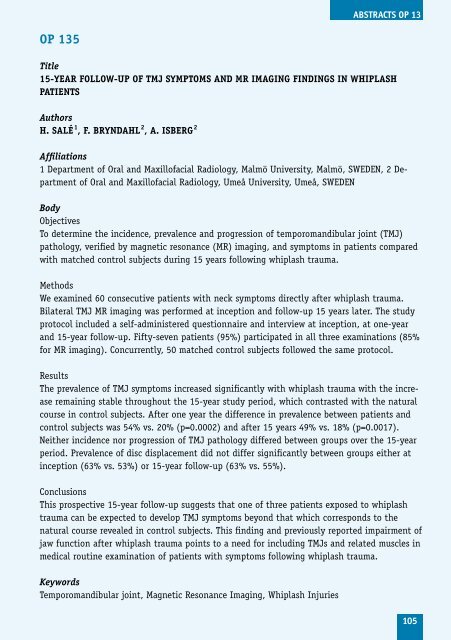Program including abstracts as pdf available here
Program including abstracts as pdf available here
Program including abstracts as pdf available here
Create successful ePaper yourself
Turn your PDF publications into a flip-book with our unique Google optimized e-Paper software.
OP 135<br />
aBSTracTS OP 13<br />
Title<br />
15-yEAR FOLLOW-uP OF TMJ SyMPTOMS AND MR IMAGING FINDINGS IN WHIPLASH<br />
PATIENTS<br />
Authors<br />
H. SALÉ 1 , F. bRyNDAHL 2 , A. ISbERG 2<br />
Affiliations<br />
1 Department of Oral and Maxillofacial Radiology, Malmö University, Malmö, SWEDEN, 2 Department<br />
of Oral and Maxillofacial Radiology, Umeå University, Umeå, SWEDEN<br />
Body<br />
Objectives<br />
To determine the incidence, prevalence and progression of temporomandibular joint (TMJ)<br />
pathology, verified by magnetic resonance (MR) imaging, and symptoms in patients compared<br />
with matched control subjects during 15 years following whipl<strong>as</strong>h trauma.<br />
Methods<br />
We examined 60 consecutive patients with neck symptoms directly after whipl<strong>as</strong>h trauma.<br />
Bilateral TMJ MR imaging w<strong>as</strong> performed at inception and follow-up 15 years later. The study<br />
protocol included a self-administered questionnaire and interview at inception, at one-year<br />
and 15-year follow-up. Fifty-seven patients (95%) participated in all three examinations (85%<br />
for MR imaging). Concurrently, 50 matched control subjects followed the same protocol.<br />
Results<br />
The prevalence of TMJ symptoms incre<strong>as</strong>ed significantly with whipl<strong>as</strong>h trauma with the incre<strong>as</strong>e<br />
remaining stable throughout the 15-year study period, which contr<strong>as</strong>ted with the natural<br />
course in control subjects. After one year the difference in prevalence between patients and<br />
control subjects w<strong>as</strong> 54% vs. 20% (p=0.0002) and after 15 years 49% vs. 18% (p=0.0017).<br />
Neither incidence nor progression of TMJ pathology differed between groups over the 15-year<br />
period. Prevalence of disc displacement did not differ significantly between groups either at<br />
inception (63% vs. 53%) or 15-year follow-up (63% vs. 55%).<br />
Conclusions<br />
This prospective 15-year follow-up suggests that one of three patients exposed to whipl<strong>as</strong>h<br />
trauma can be expected to develop TMJ symptoms beyond that which corresponds to the<br />
natural course revealed in control subjects. This finding and previously reported impairment of<br />
jaw function after whipl<strong>as</strong>h trauma points to a need for <strong>including</strong> TMJs and related muscles in<br />
medical routine examination of patients with symptoms following whipl<strong>as</strong>h trauma.<br />
Keywords<br />
Temporomandibular joint, Magnetic Resonance Imaging, Whipl<strong>as</strong>h Injuries<br />
105


